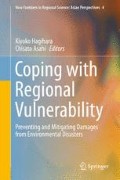Abstract
Arsenic contamination of drinking water has long been a serious problem in Bangladesh. Many foreign institutions have provided support to Bangladesh in terms of constructing arsenic-free wells, providing arsenic removal equipments and so forth. However, most of them are not accepted by local residents because they cannot understand how to maintain the equipments or their effectiveness for reducing arsenic contamination. Furthermore, they find certain equipment is too inconvenient to use in their daily lives. A survey was conducted in two villages in Bangladesh in order to define the relationship between arsenic contamination in drinking water and their social environment. First, we attempt to analyse residents’ satisfaction with the drinking water available to them. Second, we introduce the unhappiness function in our model and finally, we identify alternatives acceptable to the residents by devising a structural model addressing distrust of external support.
Access this chapter
Tax calculation will be finalised at checkout
Purchases are for personal use only
References
Cramer, H. (1946). Mathematical methods of statistics. Princeton: Princeton University Press.
Hagihara, Y. (2008). Kankyo to bousai no doboku keikakugaku (Adaptive system planning methodology for environment risk management). Kyoto: Kyoto University Press (in Japanese).
Hagihara, Y., Koizumi, A., Nishizawa, T., & Konda, T. (1979). Anketo chosa wo motonishita mizujyuyo-kouzo narabini sessui ishiki bunseki (Structure of water demand based on questionnaire survey and analysis on consciousness about saving water), Papers of civil engineering, Eisei Kougaku Kenkyu Toronkai Kouenronbunsyu (Journal of Japan Society of Civil Engineers, Environmental Research), 15, 188–193 (in Japanese).
Hagihara, Y., Hagihara, K., Hoque, B. A., Yamamura, S., Hatayama, M., Sakamoto, M., & Miyagishima, K. (2003). A study on disaster problems in Bangladesh from natural and social aspects. The Annuals of the Disaster Prevention Research Institute, Kyoto University, No. 46B, pp. 15–30.
Hossian, M. (1996). British geological survey technical report, Graphosman world atlas. Dhaka: Graphosman.
Iida, Y., & Okada, N. (1992). Dobokukeikaku system bunseki (A systems analysis of infrastructure planning). Tokyo: Morikita Publishing Co. Ltd. (in Japanese).
Kawakita, J. (1966). Hasso-ho (Method for making ideas). Tokyo: Chuko Shinsho (in Japanese).
Kinnburgh, D. G., & Smedly, P. L. (2000). Arsenic contamination of groundwater in Bangladesh, Vol. 2, final report, pp. 3–16.
Shimizu, S., Hagihara, K., & Hagihara, Y. (2002). Ninshiki de-ta wo mochiita mizube no kannkyou-hyouka (Environmental valuation on waterside by using cognitive data). Journal of Japan Society of Hydrology and Water Resources, 15(2), 152–163 (in Japanese).
Singh, N., Bhattacharga, P., & Jacks, G. (2002). Women and water, the relevance of gender perspective in integrated water resources management in rural India. ICWRER 2002 Dresden, poster session
Toyoda, H. (1998). Kyobunsan kozo bunseki (Covariance analysis: Structural equation modeling). Tokyo: Asakura Shoten (in Japanese).
Yasuda, S., & Unno, M. (1977). Shakai toukeigaku (Social statistics). Tokyo: Maruzen (in Japanese).
Author information
Authors and Affiliations
Corresponding author
Editor information
Editors and Affiliations
Rights and permissions
Copyright information
© 2016 Springer Japan
About this chapter
Cite this chapter
Fukushima, Y., Hagihara, Y., Hagihara, K. (2016). Social Environment Analysis Regarding Arsenic-Contaminated Drinking Water in Bangladesh. In: Hagihara, K., Asahi, C. (eds) Coping with Regional Vulnerability. New Frontiers in Regional Science: Asian Perspectives, vol 4. Springer, Tokyo. https://doi.org/10.1007/978-4-431-55169-0_11
Download citation
DOI: https://doi.org/10.1007/978-4-431-55169-0_11
Publisher Name: Springer, Tokyo
Print ISBN: 978-4-431-55168-3
Online ISBN: 978-4-431-55169-0
eBook Packages: Economics and FinanceEconomics and Finance (R0)

